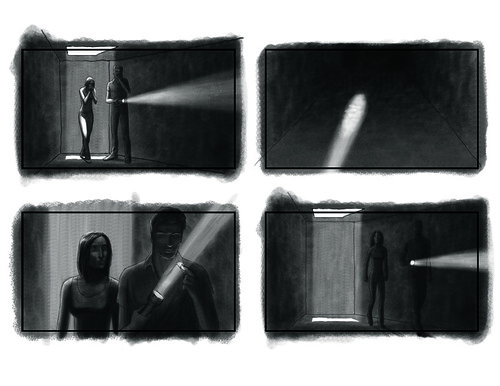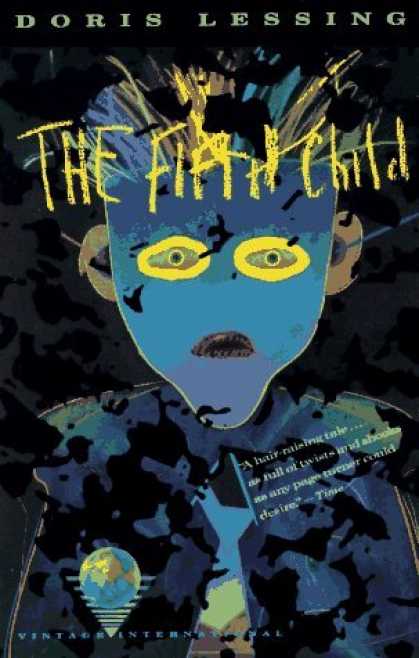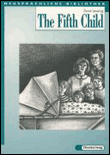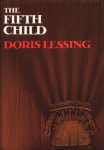-
Par C.B. le 10 May 2011 à 17:15
 Well, I've just received Loïs work and it's just awesome!
Well, I've just received Loïs work and it's just awesome!She decided to tell The Fifth Child story with a different point of view. The scene describes a dialogue between Dr Brett and the nurses. They are talking about David & Harriet.
You'll find below the text first and then the explanation.
Thank you Loïs again for your excellent work! Thank you so much!
Possible Xblogtation: We should make our pupils rewrite a text (here TFC) with a different point of view.
The text :
Dr Brett came in the room. He moved toward the coffee machine and pressed the button. He looked his cup filling slowly with the dark liquid, the one which was going to give him the energy to finish the night. A nurse came next to him, waiting for the machine to be free.
“Well, tough day isn’t it?” she said to him, expressing sympathy.
“Oh yeah, five deliveries… “He answered. He looked exhausted.
“And that one this morning wasn’t easy! God, I’ve never seen a mother so hostile to her child! “she claimed.
Another nurse who was present during this delivery came to them in order to join the discussion.
“Absolutely, refusing to nurse the baby, refusing to go out of bed… “she says, almost shivering with disgust.
Dr Brett was nodding.
“She’s got four other kids you know, she wasn’t like that during the other deliveries. I really don’t understand what’s going on in her head… During the pregnancy she was like “he’s not normal, that baby is a monster” quite frightening.” Added the doctor, and then he drank his coffee.
“I heard her say to her husband the poor kid looked like a troll! “The younger nurse said in a highly disapproval way.
“Well, he’s not a pretty baby but come on, how a mother can say something like that!” exclaimed her colleague, misunderstanding.
“ I think she’s simply victim of tiredness, first, and now the baby is here, I suspect a postpartum depression. That’s very usual, you remember this woman who was crying louder than her baby?” he was almost laughing. “It’s hard to be a mother, she’ll accept her new baby soon, all of them –well, almost- do. But personally I’m quite worried about her health. This woman is bone tired! She had five children in a very short time “Dr Brett told.
“Phew, lucky me, I’m on the pill!” said one of the nurses, laughing.
“ My pill is work, I work so much I don’t have the time to make babies ! “ added the other one, bursting out laughing. “Well, actually, talking about work, it’s time for us to start again Peggy, break’s over !” she announced to her colleague.
The two women said goodbye to the Doctor and disappeared in the hospital corridor. Dr Brett stayed a moment, lost in his thoughts. He was thinking about this new baby in the Lovatt family. He was wondering if Harriet was able to overcome her postnatal depression. He had felt anger and bitterness in her behavior toward the child, negative emotions, and he was asking himself how it was going to evolve. He had already seen mothers rejecting their babies at first, but then they were becoming loving mothers, and were accepting their children. But sometimes, it was not so easy. When he was working in the mental hospital he met a woman who was there because she killed her new born.
Dr Brett had a shiver remembering this crazy woman, how she was singing lullabies all day long : she believed her baby was still alive, and usually took care of a rolled blanket, thinking it was her baby.
The old doctor pulled himself together: no, Harriet wasn’t like that, she’ll finally accept this baby, after all he was not a monster, he was not pretty, yes, but he looked smart, his eyes yet focusing on everything… Dr Brett finished his coffee and went back to work.
Analysis and explanation:
This text deals with Dr Brett and the nurses’ point of view on Harriet and Ben. I did this because I think in this book; the reader is always manipulated by D.L, thanks to the point of view. I think most of the time we have Harriet’s point of view, so I wanted to show that maybe the other characters, and especially characters from the outside, and a doctor and nurses (who have many experiences of pregnancies, deliveries) can have a very different vision of the things. Here Dr Brett and two nurses present during Ben’s delivery are talking during their break. The nurses were shocked by Harriet behavior, and the doctor his convinced Harriet is suffering of the classical and quite common postnatal depression. I made researches about this syndrome, because when you see Harriet’s behavior, she’s clearly rejecting the baby. But I had heard that sometimes it was happening, because woman had a depression after birth, and that it was normal, and most of the time the mother succeeds overcoming this crisis. So I thought maybe Harriet is simply a victim of that, but because she is really tired, this crisis lasts a little longer. But when you think about it, after the institution episode, she is becoming a mother! But it’s too late; Ben has became violent and unsociable because she was rejecting him.
Then I imagined that Dr Brett could be worried about Harriet, because he knows she is really tired, and as a doctor he knows sometimes crazy mothers hurt their children.
I also made Dr Brett say that Ben is perfectly normal, he’s just, well, an ugly baby.
I put a touch of humor in the text to make it more realistic. But the jokes of the nurses on the pill are also there to show first that it’s the sixties, and that Harriet and David’s dream is old fashioned, because sixties girls just aspire to sexual freedom, and probably doesn’t want a lot of children, and then that shows that Harriet and David’s dream can be considered as a nightmare for lot of people, because having a lot of children demands attention, work, and is really exhausting.
 2 comments
2 comments
-
Par C.B. le 10 May 2011 à 17:07
I just love the idea and can't help thinking about all the pupils who gave me their beautiful essays with really abstract sentences! I know now the origin of their thoughts.
Possible Xbloggation: Just have fun with your pupils and show them how dangerous/funny automatic translations can be.
 1 comment
1 comment
-
Par C.B. le 9 May 2011 à 21:47
Based on the same idea as some documents we presented earlier, the following campaigns are good documents to deal with appearances for example: "...not seeing the forest for the tree".
Possible Xbloggation: Imagine what could be hidden behind the postcard, present it orally, etc.
Blogged by Latinworks.
 1 comment
1 comment
-
Par C.B. le 9 May 2011 à 00:51
Mrs CIA sent me the link to the docs. Real Star Wars fan, I couldn't but upload these!
Possible Exbloggtation: tell a story in a different way!



Blogged from adsoftheworld.
 your comment
your comment
-
Par C.B. le 9 May 2011 à 00:14
Funny idea based on the Facebook wall every user of the site uses. The idea is to imagine the wall of famous persons who are chatting, using the quotes that made them famous.
Possible Xbloggtation: Imagine the Wall of characters from the text you're studying in class for example, etc.
Advertising Agency: Quê Comunicação, Rio de Janeiro, Brazil
Creative Director: Francisco Lucchini, Eduardo Almeida
Art Director: Lucas Buléd
Copywriter: Milena Zindeluk your comment
your comment
-
Par C.B. le 5 May 2011 à 00:09
Interesting campaign based on typography. It quite old, probably needs to be updated (Ben Ladin) but the concept of drawing a portrait thanks to words illustrating it is canny.
Possible Xbloggtation: If the pupils are skilled in Photoshop they may create their own portrait, otherwise you may use it as an unknown document to exploit in class.



Blogged from Vieja magazine.
 your comment
your comment
-
Par C.B. le 4 May 2011 à 20:31
I've created two sheets for my students working on the novel The Fifth Child.
The idea was to make them understand the pattern of the initiation rite / rite of passage. They had then to identify those elements in the text.
Possible Exbloggation: The sheets can be adapted to another text. Pupils may also write/create their own initiation rite. What do you think?
Teachers, if you want the correction don't hesitate to contact me.
 4 comments
4 comments
-
Par C.B. le 4 May 2011 à 01:08
I assume you study the passage of the institution in class. The extract from the novel The Fifth Child is thrilling and really gloomy. It's a key moment of the novel and the atmosphere described is horrific.
Possible project: Why don't we try to represent the subject thanks to a storyboard?
---------------------------------------------------------------------------------------------------------
What is a storyboard?
Once a concept or script is written for a film or animation, the next step is to make a storyboard. A storyboard visually tells the story of an animation panel by panel, kind of like a comic book.
Your storyboard will should convey some of the following information:
- What charaters are in the frame, and how are they moving?
- What are the characters saying to each other, if anything?
- How much time has passed between the last frame of the storyboard and the current one?
- Where the "camera" is in the scene? Close or far away? Is the camera moving?
Why make a storyboard?
Creating a storyboard will help you plan your animation out shot by shot. You can make changes to your storyboard before you start animating, instead of changing your mind later. You will also be able to talk about your animation and show your storyboard to other people to get feedback on your ideas.
How do I make a storyboard?
Most commonly, storyboards are drawn in pen or pencil. If you don't like to draw you can also take photos, cut out pictures from magazines, or use a computer to make your storyboards. Keep in mind that your drawings don't have to be fancy! In fact, you want to spend just a few minutes drawing each frame. Use basic shapes, stick figures, and simple backgrounds. If you draw your storyboard frames on index cards, you can rearrange them to move parts of the the story around.
Storyboard Language
CLOSE-UP SHOT: A close range of distance between the camera and the subject.
DISSOVLE: A transition between two shots, where one shot fades away and simultaneously another shot fades in.
FADE - A transition from a shot to black where the image gradually becomes darker is a Fade Out; or from black where the image gradually becomes brighter is a Fade In.
HIGH CAMERA ANGLE: A camera angle which looks down on its subject making it look small, weak or unimportant.
JUMP CUT: A rapid, jerky transition from one frame to the next, either disrupting the flow of time or movement within a scene or making an abrupt transition from one scene to another.
LEVEL CAMERA ANGLE: A camera angle which is even with the subject; it may be used as a neutral shot.
LONG SHOT: A long range of distance between the camera and the subject, often providing a broader range of the setting.
LOW CAMERA ANGLE: A camera angle which looks up at its subject; it makes the subject seem important and powerful.
PAN: A steady, sweeping movement from one point in a scene to another.
POV (point of view shot): A shot which is understood to be seen from the point of view of a character within the scene.
REACTION SHOT- 1.: A shot of someone looking off screen. 2.: A reaction shot can also be a shot of someone in a conversation where they are not given a line of dialogue but are just listening to the other person speak.
TILT: Using a camera on a tripod, the camera moves up or down to follow the action.
ZOOM: Use of the camera lens to move closely towards the subject.(Blogged from http://accad.osu.edu/womenandtech/Storyboard%20Resource/ )
Terms and abbreviations for storyboard shot descriptions
Abbreviations
Video Terms
WS
Wide Shot (or LS: Long Shot)
MS
Medium Shot
CU
Close Up (or Tight Shot)
XCU
Extreme Close Up
HS
Head Shot or Head and Shoulders Shot
(talking head)Zoom
Also called a pull. From telephoto to wide angle or vice versa, slow or fast.
Pan
Turn the camera left or right
Tilt
Turn the camera up or down
INT
Interior
EXT
Exterior
Fade in
Usually fade from black
Fade out
Usually fade to black
Cut to
Switch to
Dissolve to
One shot fades into the next
Superimpose
Overlay a graphic or video
CG
Character Generator (use for overlaying text on the screen)
Abbreviations
Audio Terms
VO
Voice over (Narration)
SFX
Sound Effect
Music under
Background music
Fade in
Fade in audio
Fade out
Fade out audio
Examples of storyboards:



 your comment
your comment
-
Par C.B. le 4 May 2011 à 00:48
These are the different existing covers of the novel written by Doris Lessing.
Possible project: Why don't we try to make our pupils design their own covers?











 your comment
your comment
-
Par C.B. le 2 May 2011 à 22:22
A very striking campaign to fight against verbal violence. I love the way they use sound waves as scars to denounce that violence.
Possible exploitation: We could use the concept of representing sounds thanks to sound waves in a very specific purpose: writing a dialogue? Drawing a cartoon with sound waves? What do you think?



Blogged from http://www.kafa.org.lb/
 2 comments
2 comments
-
Par C.B. le 1 May 2011 à 23:47
Based on the same concept as Mouron & Rostain's trash to describe a character, James Mollison chose to compare the child to his or her bedroom.
Possible exploitation: As for the project presented before, teachers can use the photos/concept to make pupils imagine the bedroom of a character for example.


Jamie, 9, New-York

Kaya, 4, Tokyo

Lamine, 12, Senegal
 Dong, 9, China
Dong, 9, China
Jasmine, 4 , Kentucky (USA)
 5 comments
5 comments
-
Par C.B. le 1 May 2011 à 23:18
 The idea comes from Stéphanie Cialone and I love it!
The idea comes from Stéphanie Cialone and I love it!Based on the works by Mouron & Rostain. They collected stars' trash and made an exhibition.
Possible exploitation: teachers can adapt the idea to a lesson about mass consumption or household-waste sorting for example. It could also be a way to describe the character of a novel for example or even a country, description based on their trash. Thus the project could be dealing with stereotypes too.


Charlize Theron by Mouron & Rostain

Madonna by Rostain & Mouron

Japan by Mouron & Rostain

Malawi by Rostain & Mouron
 your comment
your comment Follow this section's article RSS flux
Follow this section's article RSS flux Follow this section's comments RSS flux
Follow this section's comments RSS flux
A blogstorming experience that will blog your mind














